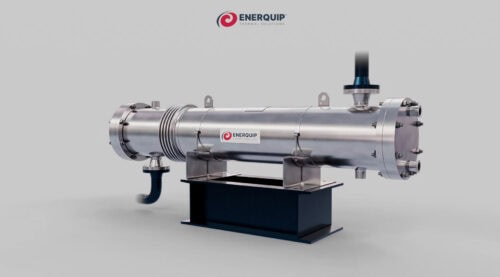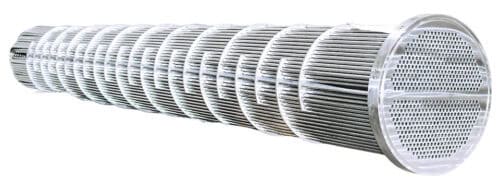When it comes to designing a shell and tube heat exchanger, one small detail can make a big difference in efficiency: baffle orientation.
Baffles are thin metal plates strategically placed within the shell. While they may look simple, they play a crucial role in heat transfer, pressure drop, and structural stability. Understanding the difference between horizontal and vertical baffles helps engineers and plant operators optimize performance for their specific process.

Take a fly-through tour to see how steam or liquid flows through a heat exchanger with baffles.
Why Baffles Matter in Heat Exchangers
Baffles inside a shell and tube heat exchanger serve three key functions:
- Support the tube bundle – preventing vibration and damage from fluid movement.
- Maintain tube spacing – keeping tubes aligned and structurally sound.
- Direct shell side flow – influencing how the fluid moves across the tubes, which directly impacts heat transfer rates and pressure drop.
The orientation of baffles—whether installed horizontally or vertically—determines how efficiently the exchanger operates.
Horizontally-Arranged Baffles
Horizontal baffles are the most common orientation and are often assumed as the default in heat exchanger design.
Advantages of Horizontal Baffles:
- Prevents fouling and deposits: Particularly effective for single-phase shell side fluids, reducing the risk of buildup at the bottom of the exchanger.
- Improves mixing: Warmer fluid at the top mixes with cooler fluid below, preventing stratification.
- Higher heat transfer rates: Longer flow paths and increased turbulence generally lead to greater heat transfer efficiency.
- Stable flow at low velocities: Helps maintain consistent fluid movement, even when shell side velocity is lower.
When to Choose Horizontal Baffles:
- Single-phase shell side operations
- Processes requiring higher heat transfer performance
- Applications where fouling is a concern
Vertically-Arranged Baffles
Vertical baffles, while less common, are a smart choice for certain process conditions.
Advantages of Vertical Baffles:
- Ideal for condensation applications: Condensate flows naturally downward toward the outlet, avoiding buildup.
- Lower pressure drop: Especially beneficial when leakage flows are present or when operating with gaseous shell side fluids.
- Simplifies two-pass exchanger design: Particularly useful in F-type shells.
When to Choose Vertical Baffles:
- Processes involving condensation on the shell side
- Systems where minimizing pressure drop is a priority
- Heat exchangers handling gaseous shell side fluids
Horizontal vs. Vertical Baffles: Key Considerations
| Factor | Horizontal Baffles | Vertical Baffles |
|---|---|---|
| Heat Transfer Rate | Generally higher | Lower, but adequate for specific cases |
| Pressure Drop | Higher (with leakage flows) | Lower |
| Best for | Single-phase fluids, higher efficiency | Condensation, gas flows, low-pressure drop needs |
| Fouling Prevention | Effective | Less effective for liquids |
Choosing the Right Baffle Orientation
There is no universal “best” option—the right choice depends on your process requirements. If maximizing heat transfer is your goal, horizontal baffles are often preferred. If lowering pressure drop or handling condensation is more important, vertical baffles may be the better fit.
For many industries, the most effective solution is a custom-designed shell and tube heat exchanger that takes into account:
- Fluid properties
- Operating pressures and temperatures
- Desired efficiency
- Maintenance considerations
Expert Guidance for Custom Heat Exchanger Design
At Enerquip, we specialize in designing and fabricating custom shell and tube heat exchangers for a wide range of industries. Our team works directly with clients to determine the most effective baffle configuration and overall design for their process.
Ready to talk? Contact our team today to explore a custom solution that fits your operation.
More from the Enerquip Blog
Freezing Fouling in Shell and Tube Heat Exchangers: What You Need to Know
7 Shell Configurations to Consider When Designing a Shell and Tube Heat Exchanger
Preventing Cross Contamination in Shell and Tube Heat Exchangers

